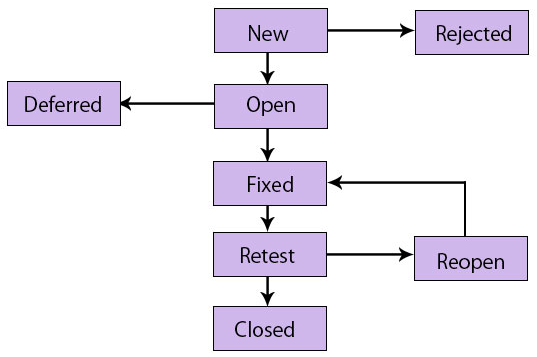Updated March 17, 2023

Introduction to Bug in Software Testing
Bug in software testing is flaw or default in a component or system or software that can cause the components or system to fail to perform its required functions, in other words, we can say that if the bug or defect encountered during the execution of the test, it may cause the failure of the components i.e. does not works as it expected from the components. For example, incorrect data definition, statements, input data, design, etc
Life Cycle of Bug in Software Testing
The Bug Life cycle is also known as a Defect Life cycle. It is a phase of a defect that occupies the different states during its lifetime. It starts when a testing device finds a new defect and ends when the testing device removes that defect and it is ensured that the defect is not replicated. It is now time to understand, through a basic diagram as shown below, the true workflow of a defect life cycle.
Below is the Diagram of the Bug life cycle:
Status of Bug
Let us see each component of the bug life cycle.
1. Open
The programmer begins the bugs analysis process here, where possible, and works to repair it. If the programmer thinks that the defect is not sufficient, then an error depending on the particular reason may be passed to the following four states, Reject or Not, namely Duplicate.
2. New
This is the first state of bug classification in the life cycle of the bugs. In the later stages of the bug life cycle validation and testing are carried out on these bugs if a new defect is discovered.
3. Assigned
The development team is allocated a newly created fault for operating on the fault at this level. This will be delegated to a designer by the project leader or the team’s boss.
4. Pending Retest
Upon fixing the defect, the designer will give the tester the fault for retesting the fault and the state of the defect stay in pending re-test ‘ until the tester works on re-testing the fault.
5. Fixed
If the developer completes the task of repairing a defect by making the necessary changes, the defect status can be called “Fixed.”
6. Verified
If the tester has no problem with the defect after the designer has been assigned the defect to the testing device and thought that if it was correctly repaired, the defect status is assigned “confirmed”.
7. Re-open
If there is still some problem with the flaw, the programmer will then be instructed to check again and the defect status will be reopened.
8. Closed
If the defect is absent, the tester changes the defect status to ‘Closed’.
9. Retest
The tester then begins the task of re-testing the defect to check whether the defect is correctly fixed by the developer as required by the requirement.
10. Duplicate
If the developer considers the defect similar to any other defect, or if the defect definition blends into any other defect, the defect status is changed by the developer to ‘duplicate’.
Parameter of Bug in Software Testing
- Date of issue, approvals, author, and status.
- Severity and incident priority.
- The test case showed the problem.
- Incident definition with reproductive steps.
Guidance for Deficiency Life Cycle Implementation
- The entire team must understand clearly the different conditions of a bug before beginning the research on the defect life cycle.
- To prevent confusion in the future, the defect life cycle should be documented properly.
- Ensure that every person with any task related to the Default Life Cycle understands his / her responsibility for better results very clearly.
- Every individual who changes the status of a defect should know the status properly which should provide enough information about the status of a defect and the reason for it so that everybody who works on that defect can easily see the reason for the defect.
- The defect tracking tool should be handled with care in the workflow of the defect life cycle to ensure consistency between the defects.
Conclusion
I hope you’ve got some knowledge of a defect’s life cycle. This article will also assist you conveniently in the future if you deal with software defects.
Recommended Articles
This is a guide to What is a Bug in Software Testing. Here we discuss the life cycle of a bug, status, parameter, and guidance. You can also go through our other related articles to learn more –

